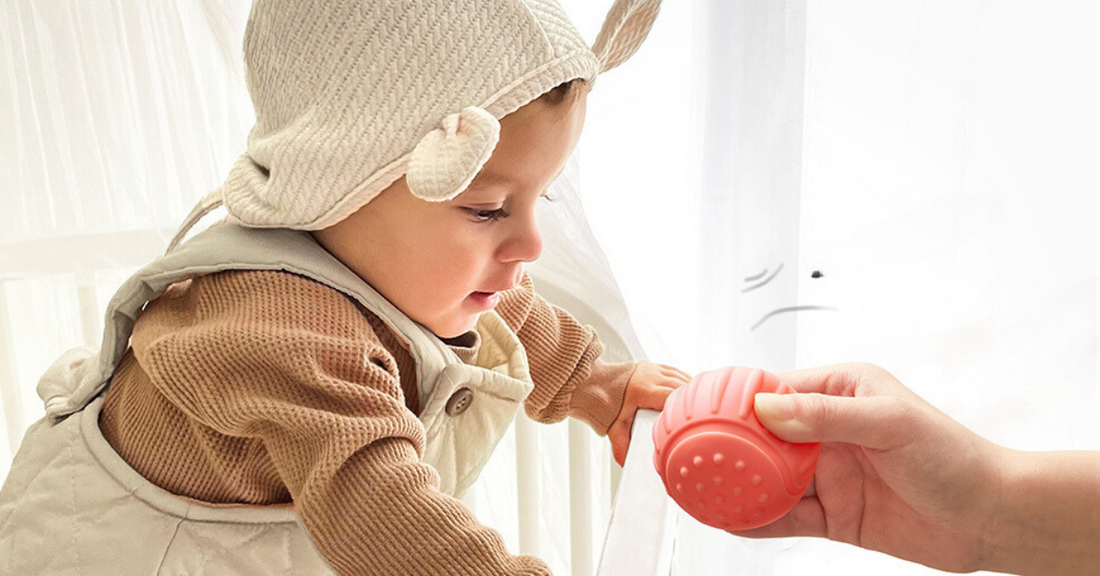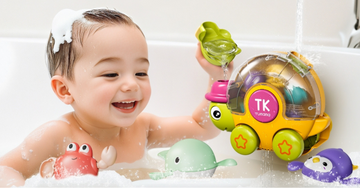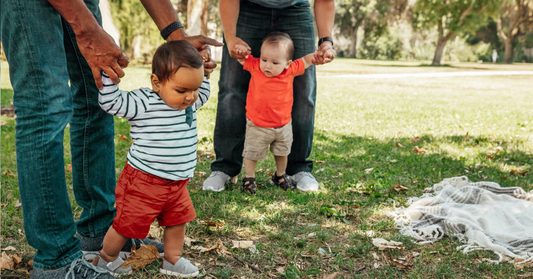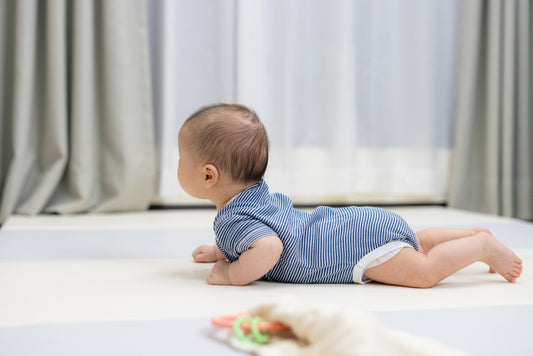Bebekler İçin Duyusal Oyun Neden Önemlidir?

Bebekler İçin Duyusal Oyun Neden Önemlidir?
Duyusal oyun, bir bebeğin erken gelişimi için gereklidir; fiziksel, duygusal ve bilişsel yeteneklerdeki büyümeyi teşvik eder. Bebekler beş duyusunu (dokunma, görme, ses, koku ve tat) kullanarak dünyayı keşfeder, bağlantılar kurar ve becerilerini geliştirir. Bu yazıda duyusal oyunun önemine, duyusal oyuncaklara ve hatta kendi duyusal oyuncaklarınızı evde nasıl üretebileceğinize bakacağız.
Duyusal Oyuncaklar Nedir?
Duyusal oyuncaklar bebeğin bir veya daha fazla duyusunu uyarmak için tasarlanmıştır. Bu oyuncaklar genellikle dikkat çeken ve keşfetmeyi teşvik eden parlak renkler, farklı dokular, rahatlatıcı sesler veya ilgi çekici desenler içerir. Yeni doğanlar için siyah beyaz duyusal oyuncaklar kartlar veya yüksek kontrastlı çıngıraklar gibi görme duyuları nedeniyle idealdir. halen gelişmektedir. Bebekler büyüdükçe ışıklı, müzikli ve yumuşak kumaşlı oyuncaklar birden fazla duyuyu harekete geçirebilir.

Duyusal Oyun Neden Önemlidir ve Duyusal Oyuncaklar Ne İşe Yarar?
Duyusal oyun, bebeklerin genel gelişimi için çok önemlidir ve duyusal oyuncaklar bu yolculukta hayati bir rol oynar. Birlikte şunları destekliyorlar:
- Beyin gelişimi : Duyuları harekete geçirmek, yeni sinir bağlantılarının oluşmasına, problem çözme, hafıza ve neden-sonucu anlama gibi bilişsel yeteneklerin geliştirilmesine yardımcı olur.
- Motor beceri gelişimi : Dokulu oyuncakları kavramak veya yumuşak nesneleri sıkmak gibi aktiviteler el kaslarını ve koordinasyonu güçlendirir.
- Duygusal gelişim : Farklı dokuları keşfetmek veya sakinleştirici sesler duymak, bebeklerin kendilerini sakinleştirmelerine ve duygularını işlemelerine yardımcı olur.
- Sosyal ve yaratıcı beceriler : Duyusal oyun genellikle etkileşimi, iletişimi öğretmeyi, takım çalışmasını ve yaratıcılığı içerir; özellikle de küçük çocuklar için.
Duyusal oyuncaklar sadece eğlenceli değildir; ayrıca bebeklerin odaklanmasına, sakinleşmesine ve çevrelerini güvenle keşfetmesine yardımcı olurlar. Yeni yürümeye başlayan çocuklar için yaratıcı oyunlara ilham verir, yaratıcılığı geliştirirken fiziksel ve duygusal büyümeyi de destekler.
Duyusal Oyuncaklar Nereden Alınır
Yüksek kaliteli bebek duyusal oyuncaklarını hem çevrimiçi hem de fiziksel konumlardaki saygın mağazalarda bulabilirsiniz. Popüler seçenekler şunları içerir:
-
Özel bebek mağazaları: Bunlar genellikle yeni doğanlardan küçük çocuklara kadar uygun çeşitli oyuncakları stoklar.
-
Çevrimiçi perakendeciler:
Tumama Kids gibi web siteleri çeşitli yenilikçi duyusal oyuncaklar sunar. -
Yerel el yapımı pazarlar: Benzersiz, zanaatkar yapımı duyusal oyuncaklar genellikle burada bulunabilir.

Küçük ellerin kavraması için mükemmel boyut –
Her eğitim paketi 10 küp içerir. Her küp, eğlenceli, parlak renklerde hayvan, harf ve sayı desenleri vb. gibi farklı bir desene sahiptir. Bu çok işlevli oyuncak saymayı, rengi, şekli ve sıralamayı tanıtmanız için harika bir yoldur: 'Orada kaç tane kırmızı var?' ve dil: 'Bu hangi hayvan?'
Duyusal Oyuncak Nasıl Yapılır
Evde duyusal oyuncaklar yaratmak özel aletler gerektirmez; sadece yaratıcılık ve güvenli, bebek dostu malzemeler yeterlidir.Kendin Yap oyuncakları hem bütçe dostudur hem de çocuğunuzun tercihlerine göre özelleştirilebilir.
Kendin Yap Duyusal Oyuncaklar
Paradan tasarruf etmek veya kişisel bir şeyler yaratmak istiyorsanız? Kendin Yap duyusal oyuncaklar yapmak, oyuncakları bebeğinizin tercihlerine göre özelleştirmenize olanak tanıyan ödüllendirici bir deneyimdir. Bazı basit, etkili fikirler için adım adım kılavuzları burada bulabilirsiniz:
Dokulu Duyusal Çanta
- Gerekli Malzemeler : Yeniden kapatılabilir büyük bir plastik torba, su, parıltı, boncuklar veya küçük nesneler (ör. düğmeler veya köpük şekiller).
- Talimatlar :
- Torbayı yarısına kadar suyla doldurun.
- Görsel uyarım için parıltı ve küçük nesneler ekleyin.
- Fazla havayı sıkın ve ardından torbayı sıkıca kapatın. Ekstra güvenlik için kenarları koli bandıyla bantlayın.
- Güvenli bir şekilde araştırmak için torbayı düz bir yüzeye yerleştirin veya mama sandalyesi tepsisine bantlayın.
- İpuçları : Sızıntıları önlemek için torbanın güvenli bir şekilde kapatıldığından emin olun. Oyun sırasında bebeğinizi denetleyin.
Yardımcı bir görsel kılavuz için bu eğiticiyi izleyin:
Duyusal Şişeler
- Gerekli Malzemeler : Şeffaf bir plastik şişe, su, gıda boyası, küçük nesneler (ör. düğmeler, ponponlar, boncuklar), isteğe bağlı sim.
- Talimatlar :
- Şişeyi yarısına kadar suyla doldurun.
- Canlı bir etki için birkaç damla gıda boyası ekleyin.
- Çeşitlilik için küçük nesneler ve parıltı ekleyin.
- Hareket için biraz hava bırakarak şişeyi suyla doldurun.
- Kapağı iyice sıkın ve sıcak tutkal veya koli bandıyla kapatın.
- İpuçları : Mavi su ve minik deniz hayvanı figürleri içeren bir okyanus şişesi gibi bir tema oluşturun.
Duyusal şişeler oluşturmaya ilişkin görsel bir kılavuz için bu eğitime göz atın. :
Kumaş Renk Örnekleri Panosu
- Gerekli Malzemeler : Karton veya ahşap çerçeve, çeşitli kumaşlar (örn. ipek, kadife, denim, keçe), yapıştırıcı veya zımbalar.
- Talimatlar :
- Kumaşları küçük kareler veya şekillerde kesin.
- Kumaşları erişilebilir bir düzende düzenleyerek kartona veya çerçeveye takın.
- Kenarların düzgün ve güvenli bir şekilde sabitlendiğinden emin olun.
- İpuçları : Tahtayı daha büyük bebekler veya küçük çocuklar için görsel olarak ilgi çekici hale getirmek için etiketler ekleyin veya zıt renkler kullanın.
Kendin Yap Gürültü Çıkarıcılar
- Gerekli Malzemeler : Boş plastik kaplar (ör. yoğurt kapları), kuru pirinç, makarna veya fasulye, bant veya yapıştırıcı.
- Talimatlar :
- Kapları küçük bir avuç dolusu kuru malzemeyle doldurun.
- Dökülmeyi önlemek için kapağı yapıştırıcı veya bantla sabitleyin.
- Daha fazla ilgi çekmek için kapları renkli bant veya çıkartmalarla süsleyin.
- İpuçları : Pirinçte yumuşak çıngıraklar veya makarnada daha yüksek çıngıraklar gibi çeşitli ses efektleri için farklı malzemeler kullanın.
Kendin Yap duyusal oyuncaklar, büyük kardeşleri, küçük erkek veya kız kardeşleri için oyuncaklar yaratmaya dahil etmek için harika bir fırsat sunar.Üstelik bütçe dostudurlar ve sonsuz eğlence sunarlar!
Sonuç
Duyusal oyun, bebeğinizin büyümesinin hayati bir parçasıdır ve oyuncaklar, onların gelişimini artırmada önemli bir rol oynar. yenidoğan duyusal kartlarını keşfetmekten kendi DIY oyuncaklarınızı yapmaya kadar, çocuğunuzun öğrenmesini ve yaratıcılığını desteklemenin sonsuz yolu vardır.
Başlamaya hazır? Bazı duyusal oyuncaklara yatırım yapın veya evinizde kendiniz yapmayı deneyin! Keşif başlasın.







0 yorumlar